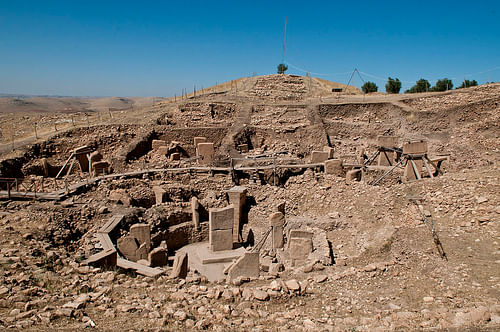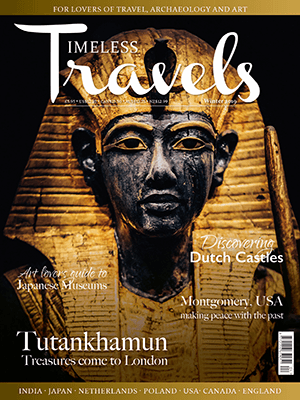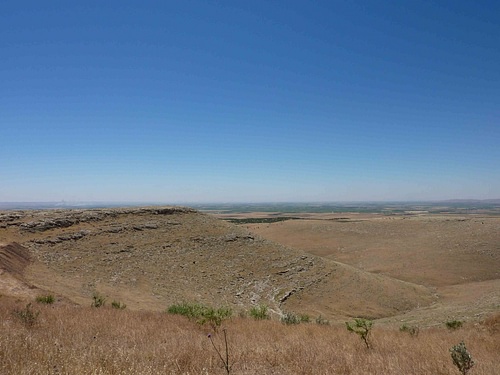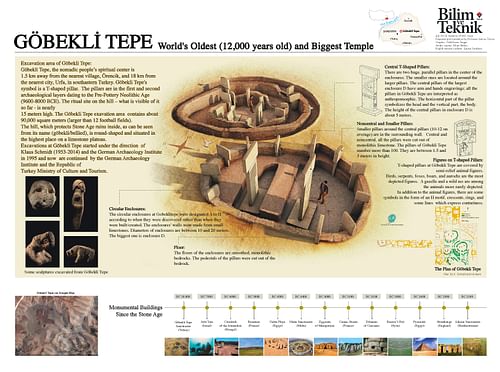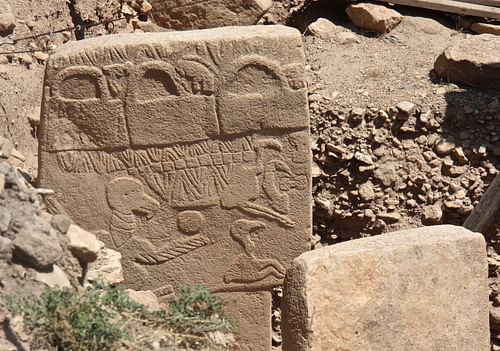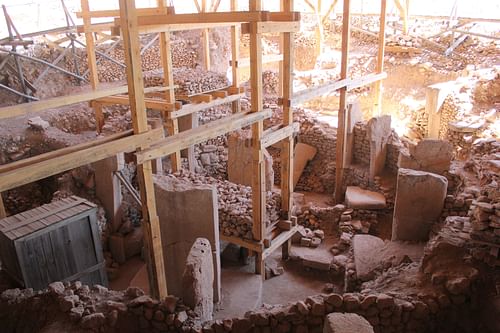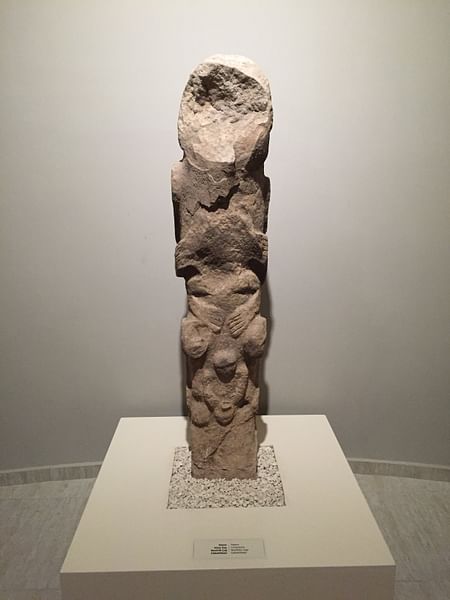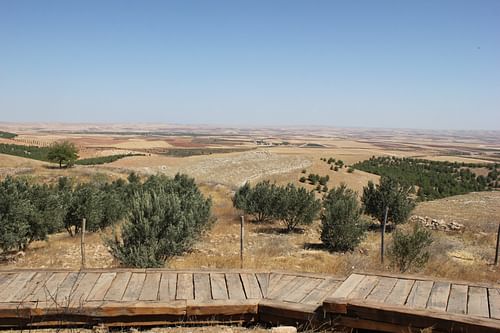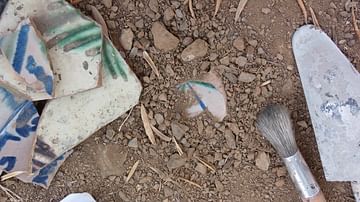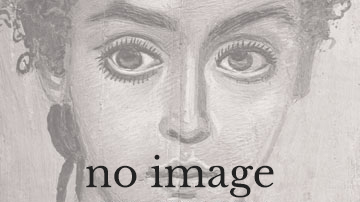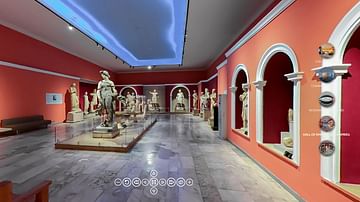Göbekli Tepe is the world's oldest example of monumental architecture; a 'temple' built at the end of the last Ice Age, 12,000 years ago. It was discovered in 1995 CE when, just a short distance from the city of Şanliurfa in Southeast Turkey, a Kurdish shepherd noticed a number of large, embedded stones, stones which had clearly been worked - and which turned out to be the most astonishing discovery.
Anatolia is described variously as a melting pot of civilisations and cultures, a bridge between Asia and Europe, a fusion of East and West, and many other familiar and overused descriptions, all now rather pedestrian but accurate nonetheless. It is certainly a fact that Anatolia has the unnerving habit of turning up 'Lost Civilisations' and 'Vanished Cultures.'
It is unnerving for two reasons: in the modern age we have covered so much ground, physically and intellectually, that we think we should know everything by now, and it is unnerving because, intrinsically, an entire civilisation is a hard thing to lose, especially in a place that is supposed to be a 'bridge' and has been tramped across by so many peoples since the very dawn of civilisation itself.
But Anatolia still does it. The story of Schliemann's discovery of Troy in 1870/71 CE had the benefit in Western culture and in the Western literary canon, of being very well known, and its discovery was a revelation and a cause for great popular wonder and excitement. The discovery and excavation of Boğazkale was another revelatory event if less celebrated by the general public. After all, the Hittites were just bit players in a biblical narrative; not wholly unfamiliar, but more of a footnote. However, academics and scholars were aware of the fact that there was a significant missing component to ancient Near Eastern history, a lacuna just hinted at by tantalising discoveries made in the late 19th century CE. The discovery and excavation of the Hittite capital, locked away in its Central Anatolian mountain vastness, in the late 19th and early 20th centuries CE filled in a huge gap, a gap reduced even further by the translation of the Hittite language by the Czech linguist Hrozny in 1915 CE, and the wealth of documentary evidence that had been turned up during excavations at the Royal Library in Hattusa, and which could now be read. However, the discovery of Göbekli Tepe was just a massive shock!
And what has emerged since that day in 1995 CE is nothing short of extraordinary; a site of significant size containing first circular 'enclosures' and then rectangular 'rooms' dominated by remarkable carved and decorated monoliths. So far, over 25 of these enclosures have been identified and two of the earlier ones have now been fully excavated down to floor level revealing an unknown and unimagined culture that turned the archaeological world on its head.
The Site of Göbekli Tepe
The most startling thing about this site is its great age. Going back to the end of the last Ice Age and first constructed around 10,000 BCE, the site is known as Göbekli Tepe (or in Kurdish, Girê Navokê meaning Pot Belly Hill, or more poetically perhaps, the Hill of the Navel).
The monument comes to us from the distant past and from a time when, according to the existing historical narrative, it simply should not have been there. This is monumental architecture on a grand scale, preserved to an extraordinary degree, but silent. While we can describe the site in minute detail and study its physical attributes with all the tools of modern science, we can only speculate as to the motives of the builders or the culture of the people; all of this was accomplished 6,000 years or more before the invention of writing.
And there is an additional riddle within this enigmatic and haunting place. The great enclosures, after being used for hundreds of years, were simply buried. The rest of the site continued to be used with smaller, more modest structures built on the mound created by the burial of the original monuments and then, after a period of use as a site for gathering and a place of ritual that may have lasted for 2,500 years, the place was simply abandoned.
Its initial construction period is referred to as 'Pre-Pottery Neolithic A' (PPNA) meaning that it comes from a period that pre-dates the invention of pottery vessels, and it also dates pre-writing. Göbekli Tepe exists in a part of human history that is unimaginably distant at the end of the last Ice Age.
Most importantly, this is in all likelihood a religious or cult site, not a settlement site; there is no evidence of anyone having lived here, although remnants of food preparation demonstrate occupation at certain times.
The construction was a huge effort and Professor Schmidt, the German archaeologist who excavated the site, believed that hundreds of people came from far and wide for specific cultural or religious rituals over an extended period of time, and then went back to their territories or hunting grounds and their daily lives. The site was only used for very important events and while no burial evidence has been found. Professor Schmidt said these could be behind the walls; "we must be patient to answer these questions and only excavate what we need."
How does one give the site a cultural and historical context? With no pottery and no writing, there can be no indication of how these ancient people perceived themselves. The archaeological team had to compare archaeological sites, taking materials from Göbekli Tepe and other sites which are related by archaeology and which can be carbon dated and compare the findings. The practice of site burial also gives an indication of age since the material used to backfill the main enclosure contained significant quantities of animal material (which can be carbon-dated).
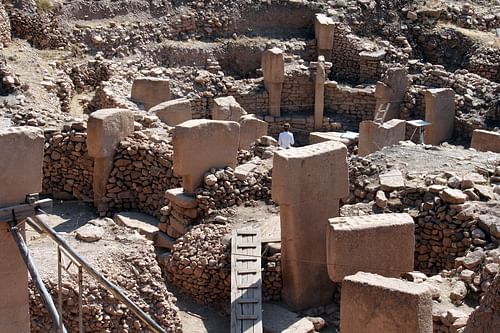
A defining characteristic of Göbekli Tepe are the monumental, T-shaped stones that are often arranged in a circle. Since the early 1990s CE a number of sites across Southeastern Turkey (essentially the northern arc of the Fertile Crescent), have emerged which have these anthropomorphic T-shaped monoliths. They have also been found in other parts of the Şanliurfa region and in the centre of Şanliurfa itself. It would seem that a number of the T-shaped stones which stand within the stone-walled circles are clearly representative of human figures and a number of them possess arms, clothing, and adornment, but significantly they have no facial features.
The other contemporary sites around the region, which include 'gatherings' of these anthropomorphic T-shaped pillars, are all a part of what is probably of mixed domestic and working environments, making what is the ritual sphere, a part of daily life. Göbekli Tepe was set apart from any domestic site and would have taken some effort not just to build but also to visit. It is also set apart, especially in its early phase, by the sheer size and monumentality of the T-shaped pillars.
This is especially true of the oldest phase of construction and use, where most of the pillars have sophisticated carved decoration and reliefs; some of them stand up to 5.5 m and weigh as much as 20 tons. The quarry that produced the stones is just a few hundred metres away where one can still see some pillars, partially excavated, but remaining in situ and attached to the bedrock but abandoned because of flaws.
The Site in Detail
The site chronology can be broken down into three levels, I, II, and III, which represent the main phases of construction and use; I being the most recent and III being the most ancient and therefore the deepest level. Layer III is also the most sophisticated level at Göbekli Tepe, a fact which poses some interesting questions: this is a site that in terms of artistic endeavour, construction, and concept seems to go backwards rather than progressing with the passage of time.
Level II is much more basic while Level I represents the thousands of years of abandonment or much later agricultural use. Factors featuring in these changes may include changing social structures, economy, and religious practice, and so on. Level I still produces many relevant finds, but these would have been relocated by erosion and farming.
While the overall size of the Göbekli Tepe site is quite considerable, the ancient core currently being excavated is of a more modest size and is represented by four enclosures identified by lettering: A-D; so designated by the order of their discovery. In level III, the oldest levels, each enclosure is characterised by different thematic components and artistic representations, and the early groups of enclosures are roughly circular in shape.
The Enclosures (Level III)
The first area to be excavated was Enclosure A which is also known as 'the snake enclosure' because depictions of snakes dominate the carvings on the T-pillars. These are, in places, extremely intricate including one (pillar no. 1) which depicts a group of tightly packed snakes contained in what appears to be a net or wicker basket, set above a wild sheep or ram. The leading edge of the stele has three carved snakes moving downwards and one snake moving up. All the snakes carved at Göbekli Tepe are carved in a downward motion except for this single example. The snakes are shown as short, thick creatures with broad flattened heads - typical of snakes which inhabit the Urfa region today, including the common Levantine viper.
It is interesting to note that the snake holds a very powerful position in the mythology of Anatolia, even today. Along with the snake, images of the fox are a consistent feature and possibly the fox has some totemic value for important members of this culture although, unlike the snake, the fox does not appear to have survived with a significant folkloric role in the wider region today.
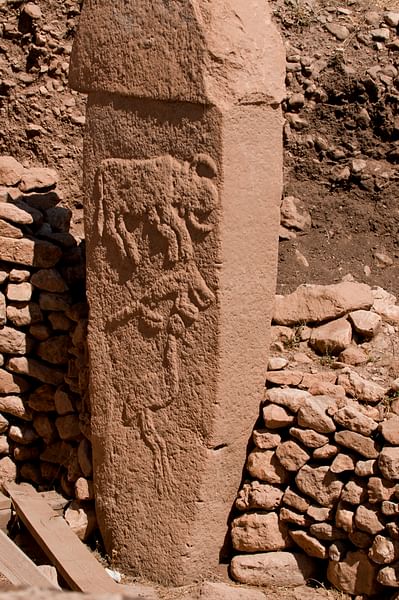
Another pillar depicts a grouping of an auroch (a very large and now extinct bovine), a fox, and a crane, positioned one above the other in what may represent a narrative of some description. This is a thought-provoking narrative because the depiction of the crane is anatomically incorrect if the carver was depicting what he actually saw in the wild, as the knees of the crane articulate backwards in the same fashion that a human knee does. Any member of a hunting and gathering society would know from an early age that a bird's knee articulates forward, and with a long-legged bird such as a crane, this forward movement is very marked indeed. What in fact may be depicted here is a human dressed as a crane. Could this be a hunting scene or possibly a depiction of a dance to invoke the attributes of the creatures being depicted?
This anatomical puzzle is repeated elsewhere. The central pillars in Enclosure A do not have the anatomical features such as arms that we see on other pillars at this site and elsewhere but the animal depictions are particularly vivid. Nor do the pillars have any obvious structural purpose.
Enclosure B is in the shape of a rough oval measuring about 10-15 m (north/ south) and about 9 m (east/west) and has a constructed terrazzo floor. This enclosure is called the 'Fox Pillars Building' because the image of the fox predominates. The two central pillars each have a life-sized fox carved on them, both facing inwards and given their posture, in mid-leap. But interestingly on one of the stones, the fox appears to be pouncing upon a small rodent-like creature that was etched into the pillar at a later date.
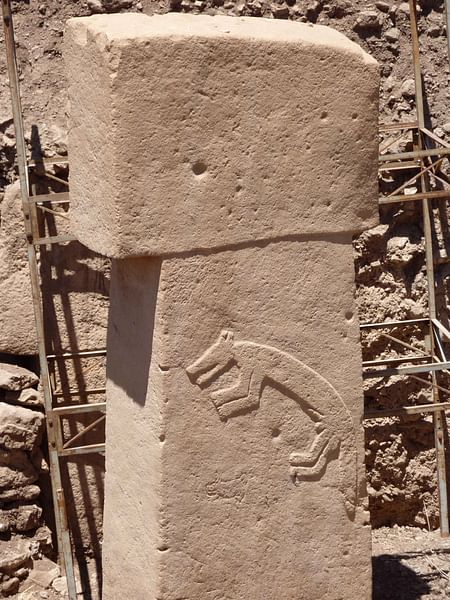
Enclosure C is dominated by superb renderings of wild boar and birds. Curiously, snakes are completely absent from this enclosure and appear to have been replaced in terms of use and positioning by images of the boar. Along with the two central pillars, there are 11 in the inner circle and, so far, eight in the outer circle; several may have been removed prior to the site's burial.
This construction is a little different in that the enclosure is built as a series of up to three concentric circles, one could even describe it as a sort of spiral. At some point after the burial of Enclosure C (possibly post Neolithic, but this is uncertain), a large 10 m diameter pit was dug in the central area of the enclosure and both standing central stones were smashed into several pieces. It is impossible to know the circumstances of this episode of iconoclastic vandalism and it is repeated elsewhere at Göbekli Tepe. It has been determined that the violence of this attack was considerable because the eastern pillar was cracked apart by an intense fire.
We do, of course, have numerous examples in our own more recent history to refer to of religious change driving destructive forces: the violence directed by English Puritans against the decorative elements in England's great medieval cathedrals and churches right down to the destruction of the Buddhas of Bamiyan by Taliban iconoclasts in Afghanistan and the cultural atrocities carried out by ISIL are merely three examples of many.
The reconstruction of the western pillar from fragments of the original is adorned with a life-sized fox relief on the inward face in mid-leap southward towards the entrance. The eastern pillar, most of which is missing was adorned with a bull on its inward face. It is fortunate that the violence was only directed at the central pillars because around the perimeter wall of Enclosure C are to be found some of the highest quality stonework at Göbekli Tepe including an extraordinary high relief (Pillar 27) of a free-standing feline above a wild boar. The enclosure is built onto the plateau's surface on the natural bedrock.
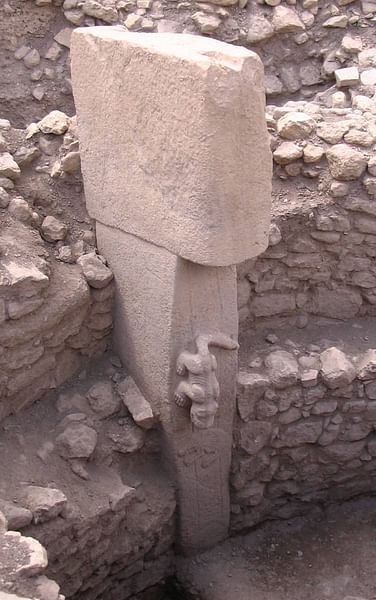
Enclosure D is referred to as the Stone Age Zoo because of the wide variety of animal imagery. The dominating feature of this enclosure is the massive pair of central T-shaped stele, clearly intended to represent human figures and monumental in scope. They face south and are set on an ornamental pedestal, one of which is decorated with what appear to be ducks, and they stand at an impressive height of 5.5 m.
Both standing pillars have arms clasped at the belly just above a decorated belt and a fox pelt loincloth with the tail hanging down at the front. The pillar standing eastwards has a life-sized fox in the crook of its right arm leaping to the south. But significantly there are no facial features. Apart from the belt and loincloth, both figures have what could be described as neck adornments which are clearly symbolic.
This enclosure also has, as one of its perimeter stones, the most discussed, and possibly disturbing set of Göbekli Tepe images of all. This is pillar no. 43, the 'Vulture Stone.' The bizarre images on this pillar include, on the left-hand side, a vulture holding an orb or egg in an outstretched wing. Lower down there is a scorpion, and the imagery is further complicated by the depiction of a headless ithyphallic man. The enclosure is also built on natural bedrock which was levelled and smoothed to construct the central pillars' pedestals and floor.
There is one further enclosure, Enclosure E, which is about 100 metres east and slightly south of this grouping of enclosures. Nothing remains except the floor plan and foundation sockets for the central pillars. The floor is carved directly from the bedrock. Just adjacent to the enclosure there are some carved depressions which may be small cisterns carved from the rock; there are other larger examples found along the ridge of Göbekli Tepe. There are no springs in the vicinity, so water supply would have been a problem. There is also a grouping of cup-like depressions carved into the rock which are replicated at other Neolithic sites in the regions, but there are no real theories as to what they may have been for.
Destruction & Reuse
All the enclosures at Level III were filled in prior to the constructions on Level II. It is unclear why this was done, but there seems to be a conscious 'decommissioning' of the structures at Level III because some pillars were damaged or moved in an organised and controlled manner, while some pillars seem to have been removed entirely. Small artefacts remained, and statues were left in situ but toppled. Some of the tops of the pillars in Enclosure C are completely broken off.
The tops of the intact central pillars have carved, cup-like depressions. It appears that when the Level III structures were buried, just the tops remained above ground and these cup-like depressions were carved once burial was complete.
Once again, the purpose of this is speculative, but receptacles for votive offerings or candles are a reasonable suggestion. With the construction and use on Level II, people were clearly using the site and would have been aware of the buried enclosures, the tops of which were protruding just above the surface, evidence of the convocation of standing stones just below. It is also reasonable to conclude that, although buried, the ancient enclosures still played a role of sorts in the ritual life of the people who continued to build and gather here.
One cannot be absolutely precise but it would seem that Level III, original construction around 9,500 BCE, was buried in phases after hundreds of years of use. The content of the material used to fill the enclosures in is a huge source of hard data. The composition of the in-fill material is simply refuse produced by hunting, food preparation, and consumption mixed in with in-fill material which included the residue of construction, stone working, thousands of flint tools, and the remnants of tool manufacture. The spoil tells us some important things about these people. The tools themselves, in the absence of the archaeologist's basic dating tool, pottery, can be used to produce a broad cultural and chronological context in which data from other sites can used to produce rough dates.
Level II is a different environment both conceptually and artistically. It is evident that the society and the culture are undergoing an important series of changes while important cultural markers remain. The enclosure spaces are far smaller and much more modest while decorations are simpler and are executed with less skill. They are also far more numerous and are constructed, almost in a jumble of competing floor plans, on top of Level III and sometimes cutting into Level III. They are certainly considerably less ambitiously monumental than before. This is possibly a society that has exhausted itself both economically and spiritually with Level III. It may be evidence of a transitional period before the abandonment of Göbekli Tepe and the evolution of more settled societies, such as the one at Çatalhöyük in the Konya Plain which is dated from about 7,500 BCE.
However, speculation aside, the most elaborate of these now more modest rectangular enclosures is the so-called 'Lion Building,' identified by the carving on one of its principle stones. While probably still a purely cult or religious site with no evidence of domesticity, the enclosures are small and in many respects resemble the domestic buildings in other places such as Nevali Çori. It could be that economic and cultural changes are reflected in construction patterns here.
Over the 2013/14 CE season, archaeologists were uncovering another enclosure, Enclosure 'H,' about 250 m away from the original Level III excavations and on the other side of the hill towards the northwest. This is referred to as the 'North West Depression' and, at first glance, looks almost to mirror the original existing excavation. Also built on Level III, this enclosure possesses good-sized central stele set in an oval-shaped structure. As with Enclosure C, representations of wild boar seem pre-eminent. The enclosure, like all the others, was buried after its useful life. However, somebody, as with Enclosure C, took the time and effort to excavate a pit, locate the central standing stones…and destroy one (the other one still awaits investigation).
Why? Clearly what connects Enclosures C and H, and possibly enclosures yet to be discovered, are design (oval and with an accessing staircase), level (age), and artwork, but above all, these two enclosures are connected by identical acts of desecration carried out long after the enclosures were buried!
These acts of desecration would suggest a number of possible scenarios none of which necessarily exclude the others. Clearly the act of burying enclosures on Level III and the evolution of the structural design changes seen on Level II indicate a conclusion of a lifecycle for these structures, and a change of political and economic, although not cultural or religious, fundamentals. The question of deliberate, targeted, and heavy destruction in enclosures but continued site use suggests a continuity of belief for a considerable period of time but with major changes in the power dynamics of the society represented at and by this extraordinary site.
The Origins of Göbekli Tepe
There are many theories contributed by non-academic and 'alternative' writers of popular books about the origins of Göbekli Tepe and its builders, most of which are understandably concerned with the amazing and very photogenic remains on Level III. They range from an 'ancient civilisation of amazing complexity' via vaguely biblical references to, quite literally, the stars. In terms of stellar alignments, the archaeological team, being careful people, who rely on slowly accumulated and assessed evidence, will not rule this out but do gently point out that there is no evidence of alignment with any star or constellation.
The site is clearly orientated, but the Level III enclosures are orientated southwards and down the Plain of Harran from where the people might have approached and not in relation to the night sky or any apparent astronomical feature; looking at the topography of the area, this would seem reasonable. Even today, the most logical approach is from the south. It is possible that this southern alignment faces a processional approach.
It is true that the act of processing features strongly in the ritual lives of ancient peoples, evidenced by ancient sites such as the proposed transition between Woodhenge and Stonehenge or the menagerie etched into the Nazca Plains right up to modern times with religious rites such as the Stations of the Cross or state ceremony such as the State Opening of Parliament in the United Kingdom. Level II enclosures display no particular alignment pattern.
After the abandonment of Level II, we see nothing happening at Göbekli Tepe other than the slow evolution of Level I, which represents the establishment of a rugged agricultural and semi-nomadic life across the environment we see today, with minor contributions during the Roman, Byzantine, and Islamic periods and which hid the drama of the numerous and silent convocations of monolithic beings just below the surface.
The name, Göbekli Tepe, or Hill of the Navel, could well be a faint cultural echo to those very distant times. It is certainly true that many Neolithic cultures were characterised by a symbolic connection to the earth via a magical navel or umbilical cord. Even today, this is a respected and venerated location to which the adorned wishing tree at the top of the mound attests.
We can only speculate as to the precise nature of the seminal changes that went on during this ancient time and which are tantalisingly represented in this amazing place. But to paraphrase a popular warning we hear today in our own rapidly evolving culture…please speculate responsibly.
